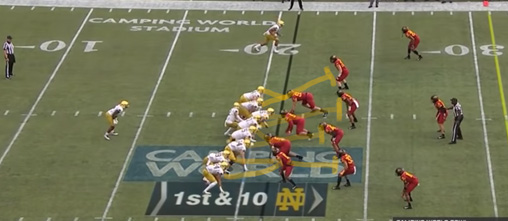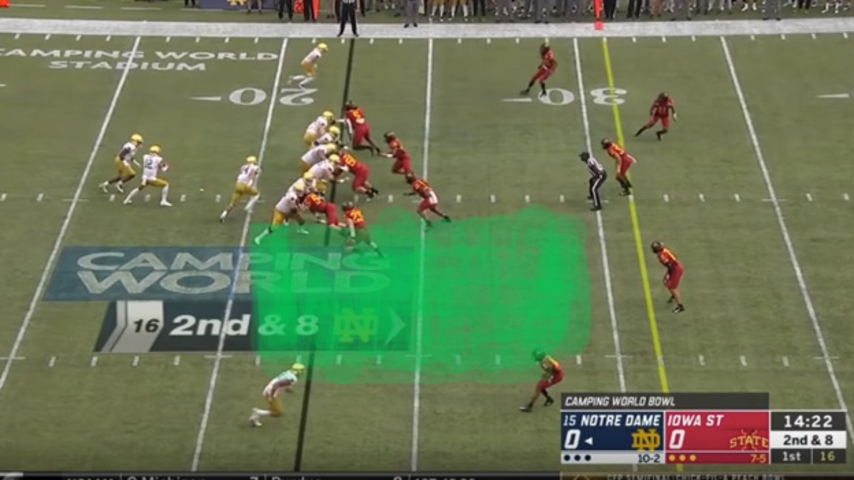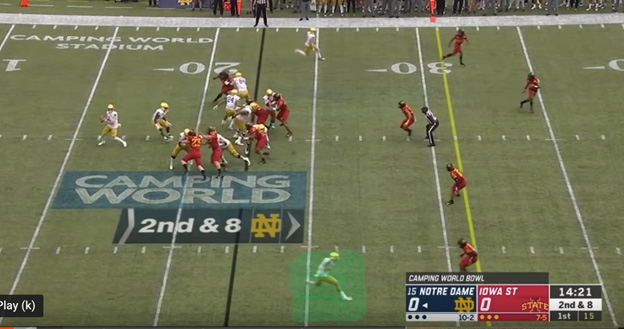
“Coach Sting” is a current coach who has spent time on both the high school and college level. He’ll be offering his expertise to Irish Sports Daily by diving into Notre Dame film and explaining what he sees. First up, he’s analyzing the small sample size we have of Tommy Rees as game-planner and play-caller.
It is an honor to introduce full breakdowns of play-calls from the new Tommy Rees Era. This new feature takes you into the mind of an offensive coordinator, the reasoning for the call, play design, and why or why not it was successful. We will dive deep into the chess match and start to discern where Notre Dame’s offense is heading into next fall!
Rees shows on his first call as OC that he wants to create favorable personnel match-ups. Iowa State is known for its 3-3-5 defense, which features five defensive backs and the Cyclones stay true to this scheme, regardless of the offensive personnel. This makes a lot of sense versus the weekly spread personnel they face in the Big12, however this can be a challenge when put up consistently against heavy personnel. Notre Dame comes out in 13 personnel (3 TE’s 1 Back) to match up against the outmanned defense to start the game.
PLAY 1
1ST & 10
Notre Dame trades all 3 TE’s to create a 6-man surface to the right side. Iowa State recognizes this and “rock n’ rolls” their safeties (rotating down to the traded-to side), but still ends up being balanced. As you can see in this illustration, this sets up perfectly for the Irish. They create a rare two extra gaps to defend versus a balanced defense that also has lots of “bubbles,” due to the 3-man defensive front. Football is and always will be a numbers game. Put the ball where the defense is not.

Notre Dame has four double-teams here, and has the bodies to account for all three LB’s and the rolled-down safety. What is even more advantageous for this old-school zone/belly play is that #11 for the Cyclones is a defensive back who is listed under 200 pounds and is tasked with setting the edge against a whole lot of mass! All is set up according to plan for the first call in Rees’ tenure.
Here is the problem with the play; the rule of thumb for those who run the belly play from under center is, never bounce belly! On this play, Jones must press the line of scrimmage, read the double-team between the playside guard and tackle and look to cut it back where the other double-teams are being performed on the down linemen. His secondary read would then be the backside inside LB. As you can see in the following picture, it all goes according to plan at the onset. The shaded green area is where the cut-back should occur and the table is set perfectly because of the vertical push at the point of contact and the backside LB’s following over the top “playside,” exactly the way Zone/Belly is designed.

Instead of this, Jones Jr. side-steps outside because he sees the devastating block on the edge, only to be met by the only unaccounted defender on the field, the playside corner, who forces it all back into a pile. Table may be set, but the poor execution in the backfield does not allow the RB to eat!
In Jones Jr.’s defense, you can see here in the following that Ian Book gets him the ball at four yards of depth. This may not seem like a big deal, but teams who make a living off of this play demand that the quarterback pushes for depth to hand the ball to the RB with a mesh point of at least six yards, thus allowing the back to make the aforementioned reads.

The problem is teams who run this concept usually major in it (think USC from late 60’s to early 2000’s) and start with these principles on day one of camp or the prior spring. They don’t try to make such a wholesale change versus a team with this defensive personnel, albeit even with the extra time a bowl game provides. Those teams will mass produce this concept and iron out the important details that tend net positive yards. This was a great idea to open the game, just poor execution and lack of the proper fundamentals to make it work.
PLAY 2
2ND & 9
While the Irish tried to go tempo right away into the next play (common after any positive yards on the 1st play from scrimmage), it took them 24 seconds to snap the ball. The reason is ND changed to 12 personnel (1 back 2 TE). By rule, the umpire must stand over the ball to give the defense a fair chance to substitute, if they so choose, therefore, slowing down the operation. Tempo is most successful anytime you can get into multiple formations with the same offensive personnel on the field.
Rees goes with a true RPO call on 2nd down. RPO is a “Run/Pass Option,” not to be confused with play-action. Unfortunately, commentators use these interchangeably each Saturday and Sunday and it can be rather confusing.
Quick side note to explain the difference.
An RPO is a called run with a “pass option” on the play. The offensive line executes the run play with no knowledge of whether or not the ball is being thrown or not. There is usually a “conflict player” or someone on defense they are trying to put in a bind. RPO’s are more prevalent in the college game, as opposed to the NFL, because of the rule differences. For NCAA rules, players can be engaged in a block up to three yards down the field (with some wiggle room) while the ball is being thrown, while the NFL has a hard rule about no more than one yard, hence the screen game being different as well (more on this another time).
Conversely, “Play-Action” is a called pass play with a fake run action. The linemen pass block while trying to keep low pad level to sell the run and confuse the defensive keys. There is no run element to a play-action pass, while RPO’s are a run-first mentality with run blocking up front. Big difference in plays, yet it seems like I’m cringing every broadcast at hearing play-action passes and other schemes being referred to as RPO’s.
Back to second down.
In this Irish RPO call, there is a version of “split zone,” which is an inside zone run play where the offensive line zone blocks one direction and the H -Back, in this case Tommy Tremble, comes across the formation to block the opposite edge, protecting the run’s backside. This is where the “split” action comes from (OL one way/H Back the other).
Most RPO’s, this one included, have a pre-snap read and a post-snap read. The pre-snap read here is what is commonly referred to as a “gift” route or a “yes/no” throw. This means that before the ball is snapped, if the QB has free access to a throw, usually a quick “3-step” route (in this case a hitch on the outside), they take it. Here, Book would’ve given the RB some type of “me” call, alerting him that he was going to throw this and making sure Jones knew to get out of the way after the fake.
While Book quickly puts his back to the throw initially, this is something where he knew he was throwing it there pre-snap.

The green area with no “overhang” defender is what Book saw pre-snap and led him to know the run portion of the RPO was off and he was throwing the free-access hitch to the field. This is absolutely the right decision on this play, given the lack of an overhang defender described and the fact that the CB is “soft,” or playing in off-coverage.
Unfortunately, on this play Chase Claypool does a poor job lowering his pads off the line of scrimmage in the drive phase of the route and selling vertical push, which is essential for any hitch route. Therefore, his feet are not underneath his shoulder pads on the break (as shown here), which leads him to slip and fall.
Incomplete.

PLAY 3
3RD & 9
On 3rd down, Rees elects to go with 11 personnel (1 Back; 1 TE) with 2 WR’s split out to the right side. The Irish ran a simple toss play to the right and I am sure at this point many Irish fans were questioning the Rees era with this call on 3rd & 9. Except, more likely than not, here is what happened.
With their twins-pro formation, the Irish probably lined up to pass on 3rd & 9. However, the Cyclones employed a “walk-around” defense with all of their LB’s “mugged up” or standing at or near the LOS. My best guess is that during their game preparation, the plan was check to an outside toss or “toss/power read” versus this defensive scheme, regardless of the down and distance. You wouldn’t expect this defense on 3rd and long, so it was a good change-up from Iowa State.
It is a good check by the Irish when you look at it. Everyone is condensed on defense and at the LOS, so take the ball outside where they are not. Up front, the OL is running a power scheme and Book is reading the end man on the line of scrimmage (EMOLOS). Since #23 from Iowa State “squeezes” down on the snap, Book tosses the ball outside. If #23 would have chased the RB right away, Book would’ve kept the ball downhill behind the pulling guard. This is set up well because all of the LB’s gave up their chests because they were “mugged” up on the LOS. There were two options on this play for Book, both of them runs.
All and all, this is a good check versus the defensive scheme, just not enough to get nine yards on 3rd down. The defense completely dictated the offensive play call and the Irish pick up 6. This puts them in a position where they are forced to punt on 4th & 3.
The first series for Tommy Rees as the offensive coordinator is less than desired with a “3 & Out,” but there was clearly lots of thought and planning that went into those 3 calls. It’s just too bad that other teams plan and practice too!
Next up: “Coach Sting” will continue going through the bowl game to gain as much understanding as possible about what we can expect from the Irish offense with Tommy Rees now in charge as coordinator.
